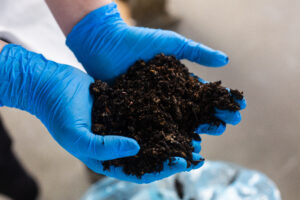Feeding Fish to Fish: How Insect Farming Fixes Fishmeal
At the beginning of 2017, I wrote a piece of research quoting Winston Churchill’s 1932 article Fifty Years Hence, in which he predicted that we would all be eating chicken grown in laboratories. While that is slowly becoming a reality (through companies such as Memphis Meats), there is another area of protein consumption that would likely have seemed even more absurd in 1932 – aquaculture. Currently, to produce 1kg of farmed fish ready for human consumption, it takes 1.5-2kg of wild-caught bait fish to be used as fishmeal. Wild-caught fish, fed to fish in farms, and then served up to humans. Does that sound odd to you?
In a recent report, the World Bank noted that during the last three decades, capture fisheries production increased from 69 million to 93 million tons, and during the same time, world aquaculture production increased from 5 million to 63 million tons. The report goes on to mention that the increasing high input requirements for capture fisheries has often been at the expense of the natural environment. Finally, it predicted that by 2030, two-thirds of fish being consumed will be farmed. Fishmeal production is therefore big business and is set to grow, all at a time when wild fish stocks are constantly reported as declining.
In another estimate, 30 million tons of wild-caught fish are currently used to feed farmed fish, with 300 million tons a year of extra fish feed required by the end of the century to meet demand. This roughly equates to a $100 billion challenge, a big reason why this space is attracting innovators and investors.
In steps innovation in the form of insect farmers for fishmeal production:

The opportunity here is bigger than fishmeal, and not only because of the larger animal feed markets that operate at much lower margins, which may be a source of revenue for these insect farmers in the future. There is also the potential of revenue from being a waste management provider. Access to a regular, stable, and high-volume source of high-protein organic waste could present the opportunity for partnerships with cities, restauranteurs, food retailers, and food production facilities in order to provide a waste recycling service. While many of the start-ups above are still in pilot phases, the issue of guaranteeing supply of ‘high-quality waste’ has been one of the greatest challenges.
Many more challenges are present in the insect farming world, but one major obstacle was overcome in July as the EU Regulation 2017/893 now permits the use of insect proteins as fish feed, derived from particular insect types. Further regulatory clarity is required in the EU, as well as other jurisdictions in order to fully remove the barrier for growth for insect farming.
Towards the end of 2016, when a venture capital investor was asked what would be the ‘big thing’ for 2017, the reply was ‘alternative proteins.’ While i3 may tell is that there are signs of increasing venture capital going into this space, the real breakthrough capital has yet to be deployed. Large-scale commercial roll-out of insect farming for fishmeal replacement is on its way, but judging by the recent investments in alternative protein companies such as Impossible Foods and others, it is easy to imagine capital being deployed soon to serve this $100 billion market.


